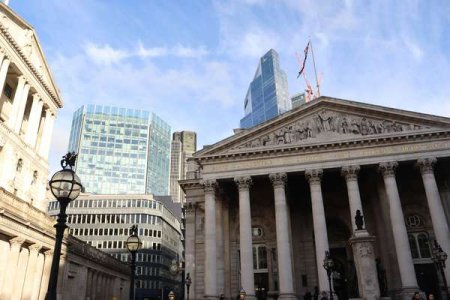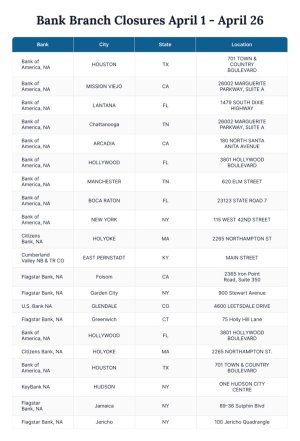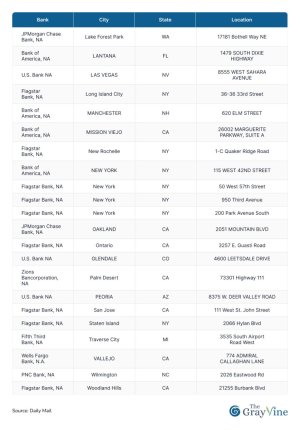Is your local bank shutting down? See the list of 42 branches closing soon
- Replies 0
If you’ve noticed more “For Lease” signs popping up where your neighborhood bank branch used to be, you’re not alone.
In just a few short weeks this spring, 42 local bank branches across the U.S. have filed for closure, leaving many communities—especially those in rural and suburban areas—wondering what comes next.
Let’s break down what’s happening, why it matters, and what you can do to protect your finances and stay connected to your money.
A Wave of Closures: What’s Happening and Who’s Affected?
US banks submitted plans to shut down 42 local branches in less than a month, reducing access to services in several communities.
From April 1 to April 26, 14 banks—including major institutions like Bank of America, Chase, and US Bank—informed the Office of the Comptroller of the Currency (OCC) of their intention to close certain branches.
Banks are mandated to notify the OCC ahead of any closures. These notices are then made public through the OCC’s weekly reports.
Though these filings signal plans to close, they do not represent final decisions. A complete list of the proposed closures, including addresses, is available below.

Flagstar Bank led the group with 16 closures—the highest number among all reporting banks during the period. The bank "did not immediately respond to DailyMail.com's request for comment."
Bank of America, which recorded the most closures in the previous year, followed closely with nine.
Chase and US Bank each shut down three locations. Other banks involved in the wave of closures include Citizens Bank, Cumberland Valley, Fifth Third Bank, FSNB, KeyBank, Pacific Premier Bank, PNC, Warsaw FS, Wells Fargo, and Zions Bancorporation.
In 2024, a total of 1,043 bank branches were closed across the US.. The pace has quickened in 2025, with 272 closures already recorded in the first quarter.
Why Are Banks Closing So Many Branches?
"Industry consolidation—both in the number of banks and branches—is a long-standing trend that will continue, especially as more transactions move online," Bankrate's chief financial analyst Greg McBride told DailyMail.com.
"Consumers and small businesses in rural areas are the most impacted, particularly business owners that must make a daily bank run to deposit cash or consumers that lack viable transportation," he added.
The wave of closures is expected to intensify throughout 2025. According to a recent study by Self Financial, the number of branches is projected to drop by an additional 4.11 percent by year’s end.
The Numbers: A Rapidly Shrinking Network
"Retail bank closures in the US aren't slowing," said Darren Kingman of Root Digital, who contributed to the Self Financial study, in an interview with DailyMail.com. "The last time this many people shared a local branch was in 1995."
He cautioned that while the country moves closer to a cashless economy, more than 200 million Americans still rely on cash deposits—leading to longer lines and declining service quality as access to branches diminishes.
Even with the ongoing digital transition, a recent survey by GoBankingRates found that 45 percent of Americans still favor in-person banking.
"The shift towards online banking is growing more intense in 2025," GoBankingRates lead data content researcher Andrew Murray told DailyMail.com.
"Despite the trend towards online banking, our survey data shows more than half of Americans are concerned about the rising number of physical branches that have shut down in the past few years," Murray added.
"Meanwhile, a whopping 76 percent says that the current banking system needs small or major changes."
Source: CNBC / Youtube.
Who’s Hit the Hardest?
More than half of respondents also expressed concern over the increasing number of bank branch closures in recent years.
Recent research has even projected that the last physical bank branch in the U.S. could shut down by 2041.
This estimate comes from Self Financial, which analyzed nationwide closure rates — averaging 1,646 net closures annually since 2018.
While most Americans now conduct their banking online, many still rely on physical branches for specific services.
Also read: Is your money at risk? A bank’s sudden closures could be just the beginning!
Older customers, in particular, often find it difficult to navigate mobile banking platforms.
According to the report, nearly two-thirds of Americans still visit physical branches to deposit cash, and over half prefer in-person meetings with banking advisers.
"Client's banking preferences and behaviors are changing, including a rapid migration toward digital and mobile banking platforms, and a desire for greater simplicity," a U.S. Bank spokesperson told DailyMail.com.
"As we evolve along with our clients, we are reevaluating our physical footprint, and in some instances, consolidating branch locations in select markets. Although we are closing some branches, we continue to open and enhance others, as well as rapidly enhancing our digital capabilities."
Wells Fargo offered a similar message in an earlier statement to DailyMail.com.
"Branches continue to play an important role in the way we serve our customers in combination with our mobile app, online website, and ATMs," a spokesperson said.
"As we optimize our branch network, we are focused on evolving our branch presence based on customer usage and the changing traffic patterns and retail landscape to best meet the banking needs of each community we serve."
What Can You Do If Your Branch Is Closing?
1. Check the List: The OCC publishes weekly reports of planned closures. If you’re concerned, ask your local branch manager or check the OCC’s website for updates.
2. Explore Alternatives: If your branch is closing, find out where the nearest location is—or if your bank partners with other institutions for shared ATM access.
3. Get Comfortable with Digital Banking: Many banks offer free classes or one-on-one help to get you started with online and mobile banking. Don’t be afraid to ask for a tutorial!
4. Consider Credit Unions: Local credit unions often have a stronger community presence and may be less likely to close branches.
5. Stay Alert for Scams: Unfortunately, scammers target people during times of change. If you receive suspicious calls or emails about your bank account, contact your bank directly using a trusted phone number.
In earlier news: Closing time? Major banks quietly shutter over 100 locations

Have you found a great way to manage your money online? Are you worried about losing your local branch? Share your experiences and tips in the comments below!
In just a few short weeks this spring, 42 local bank branches across the U.S. have filed for closure, leaving many communities—especially those in rural and suburban areas—wondering what comes next.
Let’s break down what’s happening, why it matters, and what you can do to protect your finances and stay connected to your money.
A Wave of Closures: What’s Happening and Who’s Affected?
US banks submitted plans to shut down 42 local branches in less than a month, reducing access to services in several communities.
From April 1 to April 26, 14 banks—including major institutions like Bank of America, Chase, and US Bank—informed the Office of the Comptroller of the Currency (OCC) of their intention to close certain branches.
Banks are mandated to notify the OCC ahead of any closures. These notices are then made public through the OCC’s weekly reports.
Though these filings signal plans to close, they do not represent final decisions. A complete list of the proposed closures, including addresses, is available below.

Major US banks, including Bank of America, Chase, and US Bank, have filed to close 42 local branches in just under a month, affecting services for many communities. Image source: Alicja Ziajowska / Unsplash.
Flagstar Bank led the group with 16 closures—the highest number among all reporting banks during the period. The bank "did not immediately respond to DailyMail.com's request for comment."
Bank of America, which recorded the most closures in the previous year, followed closely with nine.
Chase and US Bank each shut down three locations. Other banks involved in the wave of closures include Citizens Bank, Cumberland Valley, Fifth Third Bank, FSNB, KeyBank, Pacific Premier Bank, PNC, Warsaw FS, Wells Fargo, and Zions Bancorporation.
In 2024, a total of 1,043 bank branches were closed across the US.. The pace has quickened in 2025, with 272 closures already recorded in the first quarter.
Why Are Banks Closing So Many Branches?
"Industry consolidation—both in the number of banks and branches—is a long-standing trend that will continue, especially as more transactions move online," Bankrate's chief financial analyst Greg McBride told DailyMail.com.
"Consumers and small businesses in rural areas are the most impacted, particularly business owners that must make a daily bank run to deposit cash or consumers that lack viable transportation," he added.
The wave of closures is expected to intensify throughout 2025. According to a recent study by Self Financial, the number of branches is projected to drop by an additional 4.11 percent by year’s end.
The Numbers: A Rapidly Shrinking Network
"Retail bank closures in the US aren't slowing," said Darren Kingman of Root Digital, who contributed to the Self Financial study, in an interview with DailyMail.com. "The last time this many people shared a local branch was in 1995."
He cautioned that while the country moves closer to a cashless economy, more than 200 million Americans still rely on cash deposits—leading to longer lines and declining service quality as access to branches diminishes.
Even with the ongoing digital transition, a recent survey by GoBankingRates found that 45 percent of Americans still favor in-person banking.
"The shift towards online banking is growing more intense in 2025," GoBankingRates lead data content researcher Andrew Murray told DailyMail.com.
"Despite the trend towards online banking, our survey data shows more than half of Americans are concerned about the rising number of physical branches that have shut down in the past few years," Murray added.
"Meanwhile, a whopping 76 percent says that the current banking system needs small or major changes."
Source: CNBC / Youtube.
Who’s Hit the Hardest?
More than half of respondents also expressed concern over the increasing number of bank branch closures in recent years.
Recent research has even projected that the last physical bank branch in the U.S. could shut down by 2041.
This estimate comes from Self Financial, which analyzed nationwide closure rates — averaging 1,646 net closures annually since 2018.
While most Americans now conduct their banking online, many still rely on physical branches for specific services.
Also read: Is your money at risk? A bank’s sudden closures could be just the beginning!
Older customers, in particular, often find it difficult to navigate mobile banking platforms.
According to the report, nearly two-thirds of Americans still visit physical branches to deposit cash, and over half prefer in-person meetings with banking advisers.
"Client's banking preferences and behaviors are changing, including a rapid migration toward digital and mobile banking platforms, and a desire for greater simplicity," a U.S. Bank spokesperson told DailyMail.com.
"As we evolve along with our clients, we are reevaluating our physical footprint, and in some instances, consolidating branch locations in select markets. Although we are closing some branches, we continue to open and enhance others, as well as rapidly enhancing our digital capabilities."
Wells Fargo offered a similar message in an earlier statement to DailyMail.com.
"Branches continue to play an important role in the way we serve our customers in combination with our mobile app, online website, and ATMs," a spokesperson said.
"As we optimize our branch network, we are focused on evolving our branch presence based on customer usage and the changing traffic patterns and retail landscape to best meet the banking needs of each community we serve."
What Can You Do If Your Branch Is Closing?
1. Check the List: The OCC publishes weekly reports of planned closures. If you’re concerned, ask your local branch manager or check the OCC’s website for updates.
2. Explore Alternatives: If your branch is closing, find out where the nearest location is—or if your bank partners with other institutions for shared ATM access.
3. Get Comfortable with Digital Banking: Many banks offer free classes or one-on-one help to get you started with online and mobile banking. Don’t be afraid to ask for a tutorial!
4. Consider Credit Unions: Local credit unions often have a stronger community presence and may be less likely to close branches.
5. Stay Alert for Scams: Unfortunately, scammers target people during times of change. If you receive suspicious calls or emails about your bank account, contact your bank directly using a trusted phone number.
In earlier news: Closing time? Major banks quietly shutter over 100 locations
Key Takeaways
- Major US banks, including Bank of America, Chase, and US Bank, have filed to close 42 local branches in just under a month, affecting services for many communities.
- The trend of physical bank branch closures is accelerating, with over 1,000 branches closed in 2024 and hundreds more in early 2025; experts predict the last US branch could close as early as 2041.
- Many Americans, especially those in rural areas and older clients, are concerned about the closures, as they still rely on in-person banking for cash deposits and face-to-face advice.
- Despite the digital shift, banks say physical branches remain important for certain services, and they are adjusting their branch networks in response to changing customer behaviour and demand for digital banking options.
Have you found a great way to manage your money online? Are you worried about losing your local branch? Share your experiences and tips in the comments below!









